Derivative of tan^ {1}x) full pad » x^2 x^ {\msquare} \log_ {\msquare} \sqrt {\square} \nthroot \msquare {\square} \le \geAn online derivative calculator that differentiates a given function with respect to a given variable by using analytical differentiation A useful mathematical differentiationDerivative of 2tan(2x) Simple step by step solution, to learn Simple, and easy to understand, so don`t hesitate to use it as a solution of your homework Below you can find the full step by step solution for you problem We hope it will be very helpful for you and it will help you to understand the solving process

Derivatives Of Inverse Trigonometric Functions Sin 1 2x Cos 1 X 2 Tan 1 X 2 Sec 1 1 X 2 Youtube
Derivative of (tan^-1(2x))^2
Derivative of (tan^-1(2x))^2- · The derivative of tan^1x is 1/(1x^2) (for "why", see note below) So, applying the chain rule, we get d/dx(tan^1u) = 1/(1u^2)*(du)/dx In this question u = 2x, so we get d/dx(tan^1 2x) = 1/(1(2x)^2)*d/dx(2x) = 2/(14x^2) Note If y = tan^1x, then tany = x Differentiating implicitly gets us sec^2y dy/dx = 1," " so dy/dx = 1/sec^2y From trigonometry, we know that 1tan^2y = sec^2y so dy/dx = 1/(1tan^2y) and we have tany = x, so we get For y = tan^1x, the derivative · 3 Derivatives of the Inverse Trigonometric Functions by M Bourne Recall from when we first met inverse trigonometric functions " sin1 x" means "find the angle whose sine equals x" Example 1 If x = sin1 025 then by using the calculator, x = 15° We have found the angle whose sine is 025
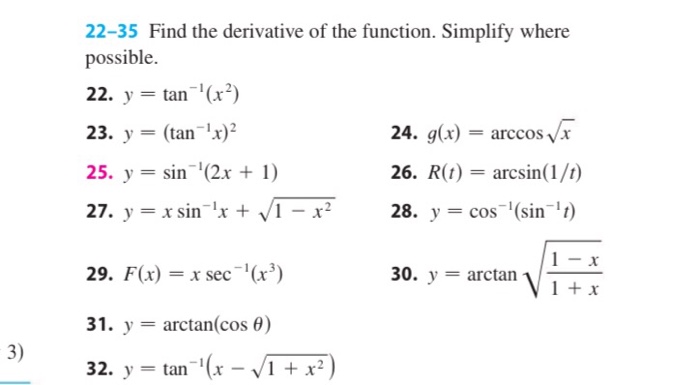


Solved 22 35 Find The Derivative Of The Function Simplif Chegg Com
By signing up, you'll get thousands of stepbystep solutions to your homework questions YouSee the answer Find the derivative of the function y = (tan −1 (2x)) 2 (Please show work) Expert Answer 100% (26 ratings) Previous question NextLet y = tan^1((√(1x²)1) /x) So tan(y) = (√(1x²)1) /x tan(2y) = 2tan(y)/1tan²(y) = 2(√(1x²)1) /x / 1((√(1x²)1) /x)² = 2x(√(1x²)1
Derivative of Tan(1/2x) Simple step by step solution, to learn Simple, and easy to understand, so don`t hesitate to use it as a solution of your homework Below you can find the full step by step solution for you problem We hope it will be very helpful for you and it will help you to understand the solving processThe derivative of `tan^ (1) 2x/ (1x^2)` with respect to `sin^ (1) 2x/ (1x^2)`, is Watch later Share Copy link Info Shopping Tap to unmute If playback doesn't begin shortly, tryDerivative of (1/2)tan(2x) Simple step by step solution, to learn Simple, and easy to understand, so don`t hesitate to use it as a solution of your homework Below you can find the full step by step solution for you problem We hope it will be very helpful for you and it will help you to understand the solving process
These little things are so important – could not find an answer and it was driving me nuts, so thanks for this little thing that is actually really importantHow to Take the Derivative of Tan x You can take the derivative of tan x using the quotient ruleThat's because of a basic trig identity, which is a quotient of the sine function and cosine function tan(x) = sin(x) / cos(x)KEAM 09 The derivative of tan 1( (2x/1x2) ) with respect to cos 1√1x2 is (A) (√1x2/1x2) (B) (1/√1x2) (2/√1x2(1x2))


What Is The Derivative Of Math Tan 1 X Math Quora



The Derivative Of Tan 1 Sqrt 1 X 2 1 X W R T
Get an answer for 'Find the derivative of f(x) = 1tan(x) / 1tan(x)' and find homework help for other Math questions at eNotes · About Press Copyright Contact us Creators Advertise Developers Terms Privacy Policy & Safety How works Test new features Press Copyright Contact us Creators0510 · The Second Derivative Of cot^2x To calculate the second derivative of a function, differentiate the first derivative From above, we found that the first derivative of cot^2x = 2csc 2 (x)cot(x) So to find the second derivative of cot^2x, we need to differentiate 2csc 2 (x)cot(x) We can use the product and chain rules, and then simplify to find the derivative of 2csc 2 (x)cot(x)



Ex 5 3 9 Find Dy Dx In Y Sin 1 2x 1 2x2 Chapter 5
.png)


Find The Derivative Of Tan 1 2x 1 X2 W R T Sin 1 2x 1 X2 Maths Continuity And Differentiability Meritnation Com
Click here👆to get an answer to your question ️ The derivative of tan^1 2x/1 x^2 with respect to sin^1 2x/1 x^2 , is · Wataru Aug 30, 14 By Chain Rule, we can find f '(x) = ex 1 e2x Note tan−1(x)' = 1 1 x2 By Chain Rule, f '(x) = 1 1 (ex)2 ⋅ ex = ex 1 e2x Answer linkAnswer to What is the derivative of \tan(1x)^{1/2}?



Solved Find The Derivative Of The Function Y Tan 1 9 Chegg Com
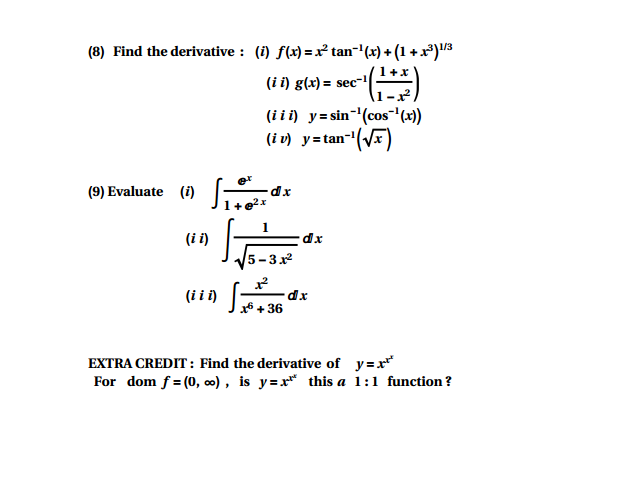


Solved Find The Derivative I F X X 2 Tan 1 X 1 Chegg Com
View this answer The derivative of tan 1 is 2 14x2 2 1 4 x 2 Finding the derivative of this function will involve the formula for the derivative of the See full answer below · µ · • § ¶ ß ‹ › « » < > ≤ ≥ – — ¯ ‾ ¤ ¦ ¨ ¡ ¿ ˆ ˜ ° − ± ÷ ⁄ × ƒ ∫ ∑ ∞ √ ∼ ≅ ≈ ≠ ≡ ∈ ∉ ∋ ∏ ∧ ∨ ¬ ∩ ∪ ∂ ∀ ∃ ∅ ∇ ∗ ∝ ∠ ´ ¸ ª º † ‡ À Á Â Ã Ä Å Æ Ç È É Ê Ë Ì Í Î Ï Ð Ñ Ò Ó Ô Õ Ö Ø Œ Š Ù Ú Û Ü Ý Ÿ Þ à á â ã ä å æ ç è é ê ë ì í î ï ð ñ ò ó ô õ öClass 12 DifferentiationRD SHARMAEX 118 Example2, Differentiate tan^1(12x\12x) with respect to (14x^2)^1/2 Differentiation Formulas1 d\dx(sin x)=co



Differentiate The Following W R T X Tan 1 1 A 2x 2 1ax



Ex 5 7 8 Find Second Order Derivatives Of Tan 1 X Ex 5 7
Derivative of 1tan(x)/1tan(x) Simple step by step solution, to learn Simple, and easy to understand, so don`t hesitate to use it as a solution of your homework · You can differentiate a function #y = tan^(1)(x^2)# by using implicit differentiation So, if you have a function #y = tan^(1)(x^2)#, then you know that you can write #tan(y) = x^2# Differentiate both sides with respect to #x# to get #d/(dy)(tany) * (dy)/dx = d/dx(x^2)# #sec^2y * (dy)/dx = 2x# This is equivalent to saying that #(dy)/dx = (2x)/sec^2y#This is done through implicit differentiation just as mathsin^{1}(x)/math or mathcos^{1}(x)/math however, there's a bit twist to this one mathy = tan



Ex 5 3 10 Find Dy Dx In Y Tan 1 3x X3 1 3x2 Ex 5 3


Differentiate Tan 1 1 X 2 X With Respect To Cos 1 2x 1 X 2 When X 0 Sarthaks Econnect Largest Online Education Community
Derivative of ln(tan(2x)) Simple step by step solution, to learn Simple, and easy to understand, so don`t hesitate to use it as a solution of your homework Below you can find the full step by step solution for you problem We hope it will be very helpful for you and it will help you to understand the solving processThis calculus video tutorial shows you how to find the derivatives if inverse trigonometric functions such as inverse sin^1 2x, tan^1 (x/2) cos^1 (x^2) taThe derivative of tan1 ((√1x2 1/x)) wrt tan1 ((2x√1x2/12x2)) at x = 0 is (A) (1/8) (B) (1/4) (1/2) (D) 1 Check Answer and Solut
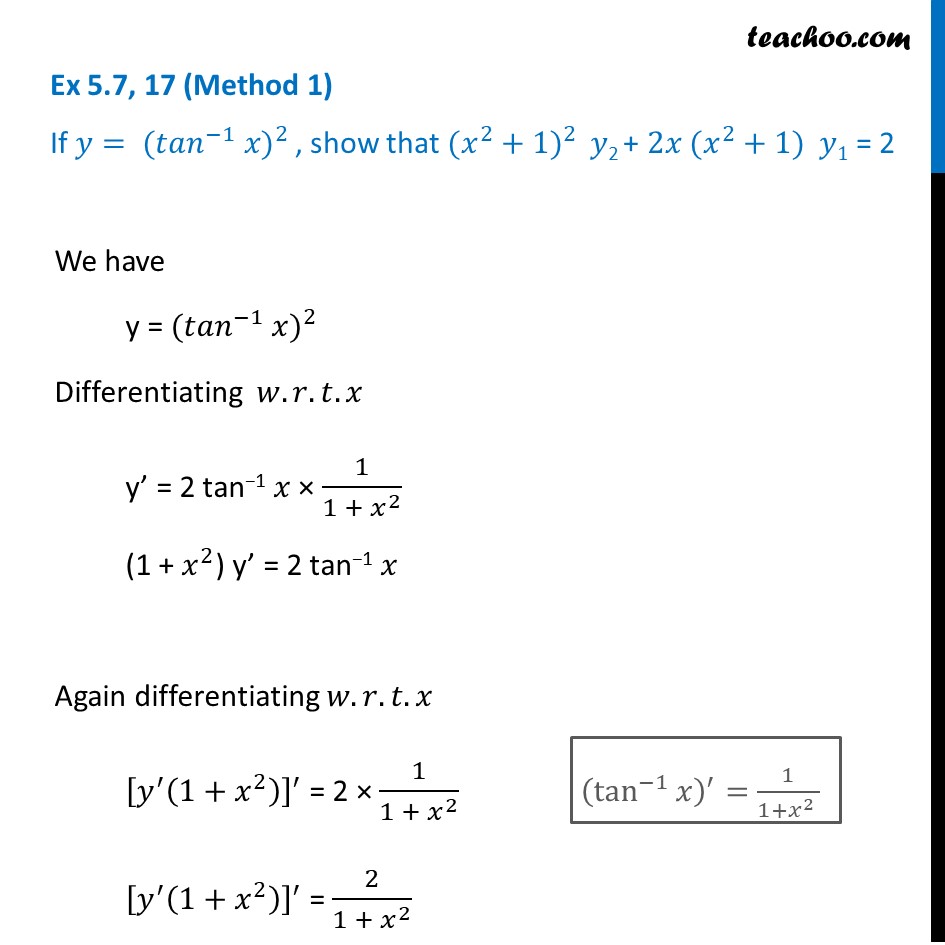


Ex 5 7 17 If Y Tan 1 X 2 Show X2 1 Y2 2x X2 1



The Derivative Of Tan 1 Sqrt 1 X 2 1 X With Respect To Tan
Find nth derivative of tan1(2x/1x2) This video is the solution of above question Please like subscribe and share Thank you · See also Secant function;Question Find The Derivative Of The Function Y = (tan−1(2x))2 (Please Show Work) This problem has been solved!



Solved 49 60 Find The Derivative Of The Function Simplif Chegg Com



Derivatives Of Inverse Trigonometric Functions Sin 1 2x Cos 1 X 2 Tan 1 X 2 Sec 1 1 X 2 Youtube
\\frac{d}{dx} \frac{1}{\tan{x}}\ > < · Stack Exchange network consists of 177 Q&A communities including Stack Overflow, the largest, most trusted online community for developers to learn, share their knowledge, and build their careers Visit Stack ExchangeThe derivative of tan^1 (√1 x^2 1) / x with respect to tan^1 (2x √1 x^2) / (1 2x^2) at x = 0 is
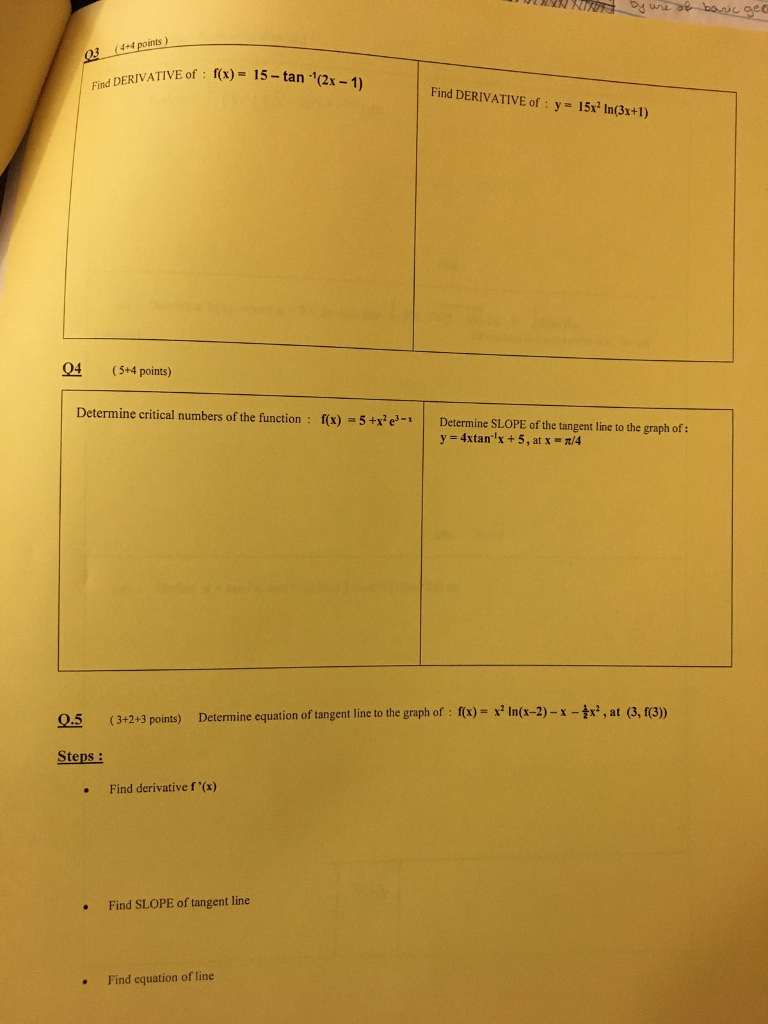


Solved Find Derivative Of F X 15 Tan 1 2x 1 Find D Chegg Com


Derivatives Of Inverse Trigonometric Functions
The derivative of tan^1 2x/1 x^2 with respect to sin^1 2x/1 x^2 , isFree implicit derivative calculator implicit differentiation solver stepbystep This website uses cookies to ensure you get the best experience By using thisDerivative of inverse tangent Calculation of Let f(x) = tan1 x then,



Differentiate The Following W R T X Tan 1 E 2x 1e 2x 1



The Derivative Of Tan 1 Sqrt 1 X 2 1 X With Respect To Tan
Maxima takes care of actually computing the derivative of the mathematical function Like any computer algebra system, it applies a number of rules to simplify the function and calculate the derivatives according to the commonly known differentiation rules Maxima's output is transformed to LaTeX again and is then presented to the user2909 · The Second Derivative Of tan^2x To calculate the second derivative of a function, differentiate the first derivative From above, we found that the first derivative of tan^2x = 2tan(x)sec 2 (x) So to find the second derivative of tan^2x, we need to differentiate 2tan(x)sec 2 (x) We can use the product and chain rules, and then simplify to find the derivative ofClick here👆to get an answer to your question ️ The derivative of tan^1 (√(1 x^2)1/x ) with respect to tan^1 (2x√(1 x^2)/1 2x^2 ) at x = 0 is
.png)


Find The Derivative Of Tan 1 2x 1 X2 W R T Sin 1 2x 1 X2 Maths Continuity And Differentiability Meritnation Com


What Is The Nth Derivative Of Arctan 2x 1 X 2 In Terms Of R And Theta Quora
0211 · The Second Derivative Of tan (2x) To calculate the second derivative of a function, you just differentiate the first derivative From above, we found that the first derivative of tan (2x) = 2sec 2 (2x) So to find the second derivative of tan (2x), we just need to differentiate 2sec 2 (2x)In mathematics, the inverse trigonometric functions (occasionally also called arcus functions, antitrigonometric functions or cyclometric functions) are the inverse functions of the trigonometric functions (with suitably restricted domains)Specifically, they are the inverses of the sine, cosine, tangent, cotangent, secant, and cosecant functions, and are used to obtain an angle from any of · The inverse tangent — known as arctangent or shorthand as arctan, is usually notated as tan1 (some function) To differentiate it quickly, we have two options 1) Use the simple derivative rule 2) Derive the derivative rule, and then apply the rule In this lesson, we show the derivative rule for tan1 (u) and tan1 (x)



Q31 If Y Tan 1 X 2 Then Show That X 2 1 2 D 2 Y Dx 2 2x X 2 1 Dy Dx 2 Youtube



Derivative Of Arctan X Inverse Tangent Detailed Lesson
· Differentiate the following function with respect to x tan^1{(√(1a^2x^21)/(ax)}, x ≠ 0 asked 4 days ago in Differentiation by Kaina ( 52k points) differentiation



Differentiate Tan 1 1 X2 1 2 1 X Wrt Sin 1 2x 1 X2 Explain In Great Detail Mathematics Topperlearning Com Yx862gdd



Drill Find Dy Dx Y X 3 Sin 2x Y E 2x Ln 3x 1 Y Tan 1 2x Product Rule X 3 2cos 2x 3x 2 Sin



Differentiate The Following By Using First Principle I Tan 2x 1 Ii Tan X Iii Maths Limits And Derivatives Meritnation Com


Derivative Of Inverse Tangent



How Do You Find The Derivative Of Sin 1 2x 1 Socratic


How To Find The Nth Derivative Of Math Tan 1 X Math Quora


Derivative Of Tan



Differentiate The Following From First Principle Tan 2x 1
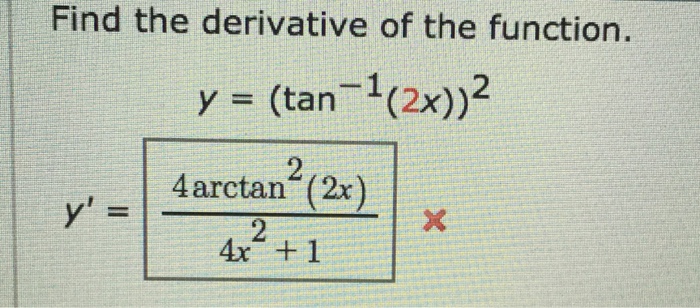


Solved Find The Derivative Of The Function Y Tan 1 Chegg Com



What Is The Derivative Of E Log 1 Tan 2 X Quora



Solved 22 35 Find The Derivative Of The Function Simplif Chegg Com



Y Tan 1 Sqrt 1 X 2 Sqrt 1 X 2 Sqrt 1 X 2 Sqrt 1 X 2 W H E R E 1 Ltx Lt1 X 0 Youtube
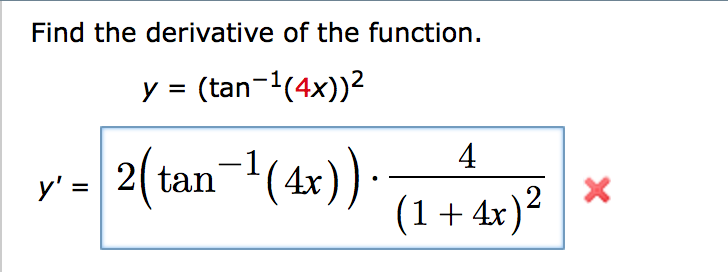


Solved Find The Derivative Of The Function Y Tan 1 4x Chegg Com



What Is The Nth Derivative Of Arctan 2x 1 X 2 In Terms Of R And Theta Quora


The Differential Coefficient Of Tan 1 2x 1 X 2 With Respect To Sin 1 2x 1 X 2 Is Sarthaks Econnect Largest Online Education Community



Derivative Of Tan Inverse With Chain Rule Youtube



If F X Tan 1 2x Find Lim X Gt 2 F X F 2 X 2 A 2 17 B 1 17 C 2 15 D 1 15 Brainly Com



Deriving The Derivative Of Inverse Tangent Or Y Arctan X Youtube



Differentiate The Following By Using First Principle I Tan 2x 1 Ii Tan X Iii Maths Limits And Derivatives Meritnation Com



Ex 2 2 5 Simplify Tan 1 Root 1 X2 1 X Chapter 2
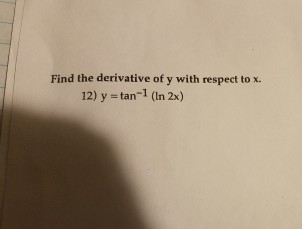


Solved Find The Derivative Of Y With Respect To X Y Ta Chegg Com


What Is The Derivative Of Tan 1 4x 4 X 2 Quora


Prove That Tan 1 1 X2 1 X2 1 X2 1 X2 P 4 1 2 Cos 1x2 Studyrankersonline
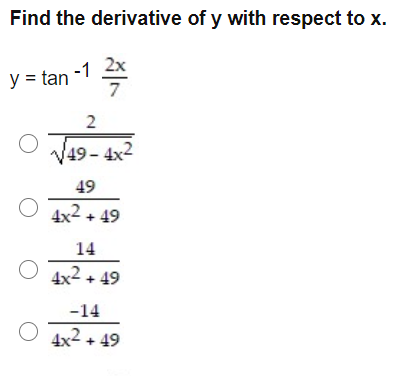


Solved Find The Derivative Of Y With Respect To X Y Ta Chegg Com
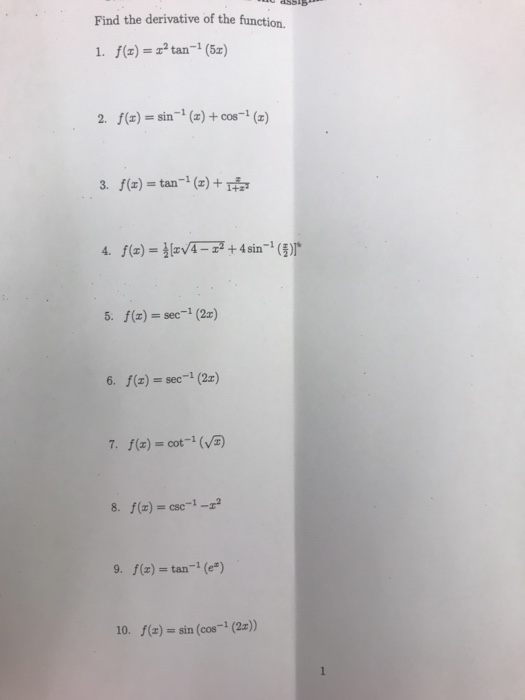


Solved Find The Derivative Of The Function 1 F X Tan Chegg Com



How To Solve Tan 1 2x 1 X2 Cot 1 1 X2 2x Pie 3 Brainly In



Differentiate Tan 1 Sqrt 1 X 2 X Wrt Cos 1 2xsqrt 1 X 2 If Xepsilon 1 Sqrt2 1 Youtube



Second Derivative Of Tan 2x Youtube


What Is The Value Of Dy Dx If Y Tan 1 4 X 1 4x Quora



Integration Of Tan 1 5x 1 6x 2 Dx Mathematics Topperlearning Com Zb45f7yy


Differentiate Tan 1 1 X 2 1 X With Respect To Sin 1 2x 1 X 2 If 1 X 1 X 0 Sarthaks Econnect Largest Online Education Community


The Derivative Of Tan 1 1 X 2 1 X With Respect To Tan 1 2x 1 X 2 1 2x 2 At X 1 2 Is Sarthaks Econnect Largest Online Education Community



Derivative Of Tan Inverse



Find Dy Dx If Y Tan 1 4x 1 5x 2 Tan 1 2 3x 3 2
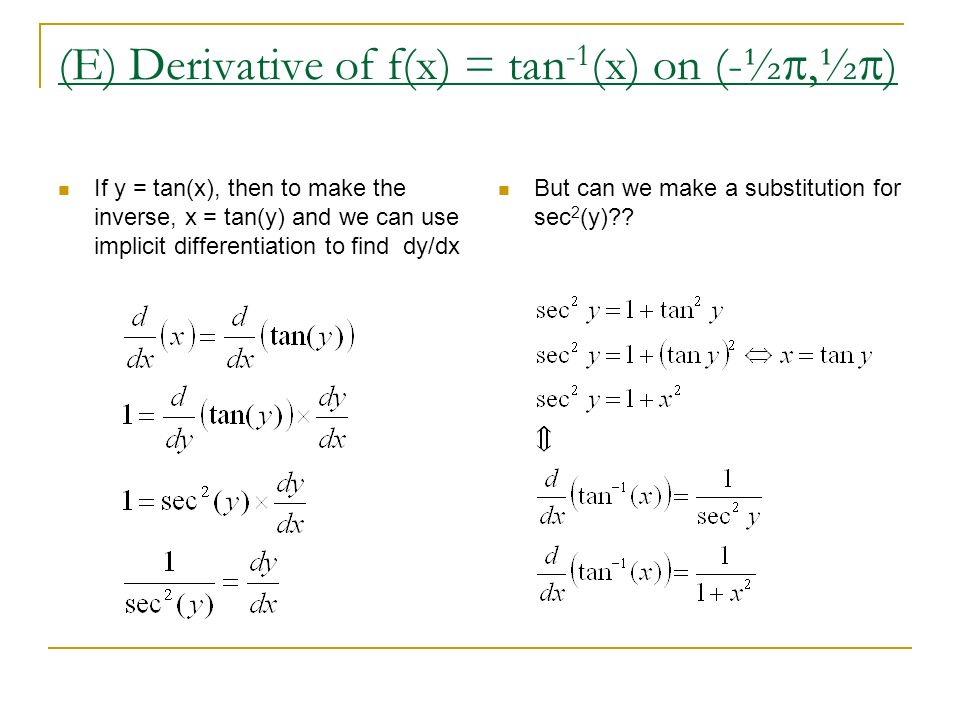


B1 6 Derivatives Of Inverse Trig Functions Ppt Download



Differentiate Each Of The Following W R T X Tan 1 2x1 15x 2


What Is The Derivative Of Tan 1 Sec X Tan X Quora



Derivative Of Tan X Old Video Khan Academy



Derivative Of Arctan X Inverse Tangent Detailed Lesson



Find The Derivative Of X Tan 1 X With Respect To X


Derivatives Of Trigonometric Functions



The Derivative Of Tan 1 Sqrt 1 X 2 1 X With Respect To Tan
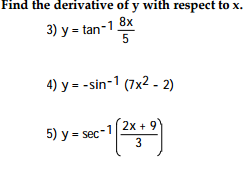


Solved Find The Derivative Of Y With Respect To X Y Ta Chegg Com



The Value Of Derivative Of Tan 1 2x Sqrt 1 X 2 1 2x 2
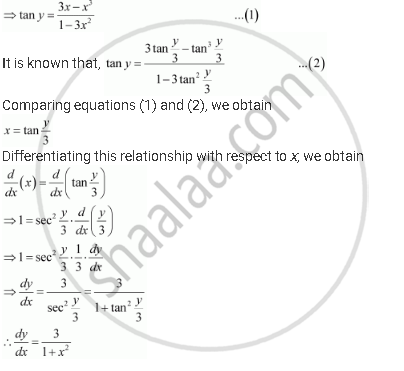


Find Dy Dx For Y Tan 1 3x X 3 1 3x 2 1 Sqrt3 X 1 Sqrt3 Mathematics Shaalaa Com



Misc 44 Value Fo Tan 1 2x 1 1 X X2 Dx Is Miscellaneous


What Is The Derivative Of Math Tan 1 X Math Quora



The Derivative Of Tan 2x Derivativeit


Find The Derivative Of Following Functions W R T X I Tan 1 A X 1 Ax Sarthaks Econnect Largest Online Education Community


What Is The Value Of Dy Dx If Y Tan 1 4 X 1 4x Quora



Derivative Of Arctan 2x Youtube



Find Nth Derivative Of Tan 1 2x 1 X2 Youtube



The Derivative Of Tan 2x Derivativeit



Derivative Of Arctan X Inverse Tangent Detailed Lesson


How To Differentiate Y Tan 1 2x 1 X 2 For The Inverse Trigonometric Function Quora



How To Differentiate Tan Inverse X By First Principle Quora
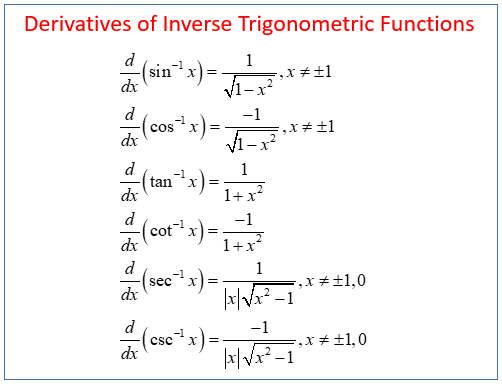


Calculus Inverse Trig Derivatives Video Lessons Examples And Solutions
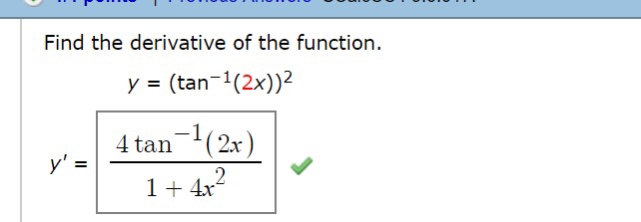


Solved Find The Derivative Of The Function Y Tan 1 2x Chegg Com
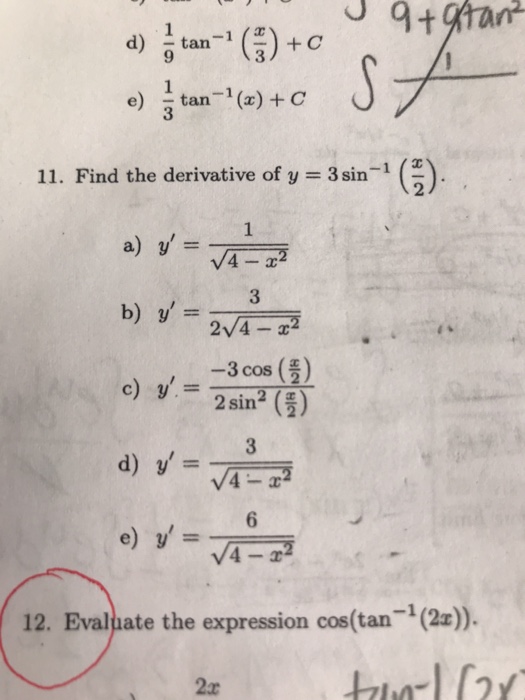


Solved D Tan 9 3 E 3 Tan 1 A C 11 Find The Derivati Chegg Com



Differentiate Tan 1 1 X2 1 2 X Wrt Cos 1 2x 1 X2 1 2 When X 0 Explain In Great Detail Mathematics Topperlearning Com Hpg5zbkk
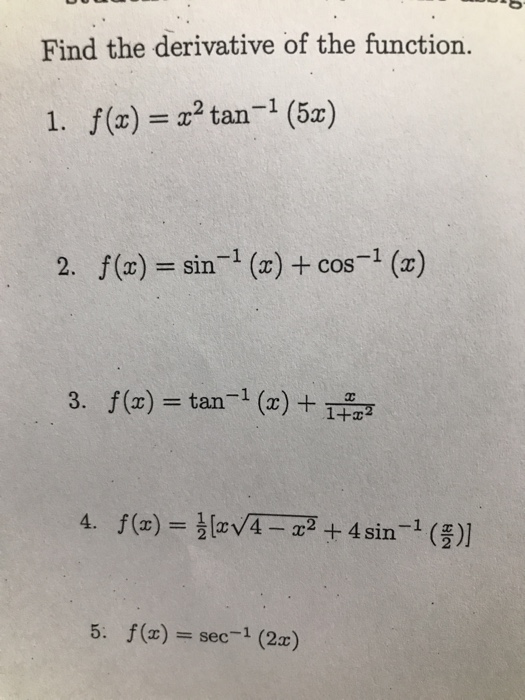


Solved Find The Derivative Of The Function 1 F X X2 Chegg Com



Show That Z Ln X 2 Y 2 2 Tan 1 Y X Satisfies The Laplaces S Equation Mathematics Stack Exchange



The Derivative Of Tan 1 Sqrt 1 X 2 1 X W R T Tan 1x Is Youtube



Solved 2 Find The Derivative A Y Tan 1 Vx B Y Vtan 1 Chegg Com
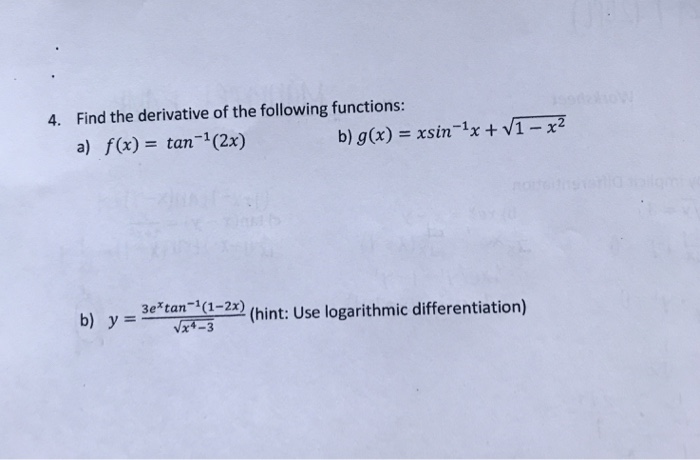


Solved Find The Derivative Of The Following Functions A Chegg Com



The Derivative Of Tan 1 2x 1 X 2 With Respect To Sin 1 2x 1 X 2 Is Youtube
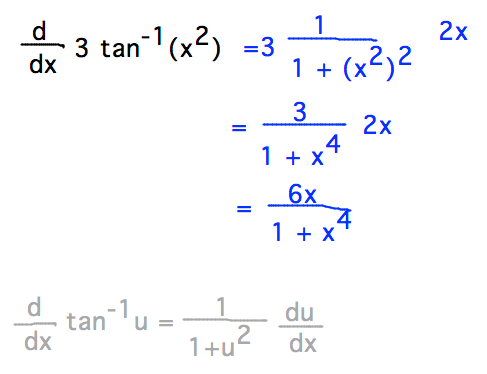


Geneseo Math 222 01 Inverse Trig Functions



Solved Find The First Derivative Of The Following Functio Chegg Com



05 Derivative Of Tangent Function Tan2x And Tanx 2 Youtube



Differentiate Tan 1 X 1 X 2 With Respect To Sin 1 2x 1 X 2



What Is The Derivative Of Sec 2 Tan 1 X With Respect



Solved Find The Derivative Of Each Of The Following Inver Chegg Com



Integration Of Inverse Tan 2x Integration By Parts Youtube



Derivative Of Inverse Tan X By First Principle Method Youtube


How To Find Derivative Of Y Sin 2x 1 X 2 Quora


What Is The Derivative Of Tan 1 Sec X Tan X Quora



The Derivative Of Tan 1 Sqrt 1 X 2 1 X With Respect To Tan



Tan 1 3 2x 1 6x Differentiate W R T X



No comments:
Post a Comment